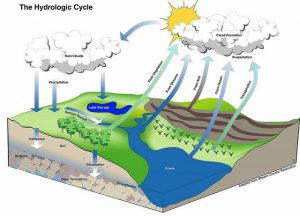Geology Notes On – Hydrology – For W.B.C.S. Examination.
It is the science of water which deals with the occurance, circulation and distribution of water on earth’s surface and it atmosphere.Continue Reading Geology Notes On – Hydrology – For W.B.C.S. Examination.
Hydrological Cycle :
It is a cycle in which water moves from one phase to another having different residence time. Over the ocean surface evaporation is greater than precipitation whereas on land precipitation is greater than evaporation. Sun is source of energy which drives hydrological cycle.
Residence Time :
This is the time taken by water particle in crossing one particular phase of hydrological cycle. The area draining into the river or stream is called the catchment area of that particular stream with respect to given location. In US English catchment area is also called as Watershed while in British English, ridge is termed as Watershed.
- Rain : This is principal mode of precipitation in India. This denotes water droplets ranging from 0.5mm to 6mm. On the basis of Intensity, rainfall is classified into follows.
1. 0-2.5mm/hour – Light Rainfall
2. 2.5-7.5mm/hour – Medium Rainfall
3. More than 7.5mm/hour – Heavy Rainfall.
In India, rainfall data is collected everyday at 8.30AM and if this rainfall is more than 2.5mm on a day then that day is called Rainy Day. - Snow : These are ice crystals having a density of 0.1gm/cc
- Drizzle : These are fine droplets of water whose size is less than 0.5mm and intensity is less than 1mm/hour.
- Glaze : When droplets of water comes in contact with cold ground surface of approximately 0 degrees Celsius, then water is converted into ice which is called Glaze.
- Sleet : This is frozen raindrop of transparent nature.
- Hail : This is lumpse of ice whose size is more than 8mm. As per WMO or International Standards (World Meteorological Organization) lumps of ice greater than 5mm is called Hail and of less than 5mm is called Groupel.
The study of water in all its forms (rain, snow and water on the earth’s surface), and from its origins to all its destinations on the earth is called hydrology.
- Water is one the most valuable natural resources essential for human and animal life, industry and agriculture.
- It is also used for Power generation, navigation and fisheries.
- Tremendous importance is given to the hydrology all over the world in the development and management of water resources for irrigation, water supply, flood control, water-logging and salinity control, Hydro power and navigation.
- The hydrologic cycle describes the continuous re–circulating transport of the waters of the earth, linking atmosphere, land and oceans.
- Water evaporates from the ocean surface, driven by energy from the Sun, and joins the atmosphere, moving inland as clouds. Once inland, atmospheric conditions act to condense and precipitate water onto the land surface, where, driven by gravitational forces, it returns to the ocean through river and streams.
- The process is quite complex, containing many sub-cycles.
- Engineering Hydrology takes a quantitative view of the hydrologic cycle.
- The quantification of the hydrologic cycle which is an open system can be represented by a mass balance equation, where inputs minus outputs are equal to the change in storage.
- It is a basic Hydro-logic Principle or equation that may be applied either on global or regional scale
Please subscribe here to get all future updates on this post/page/category/website


 +919674493673
+919674493673  mailus@wbcsmadeeasy.in
mailus@wbcsmadeeasy.in







































































































